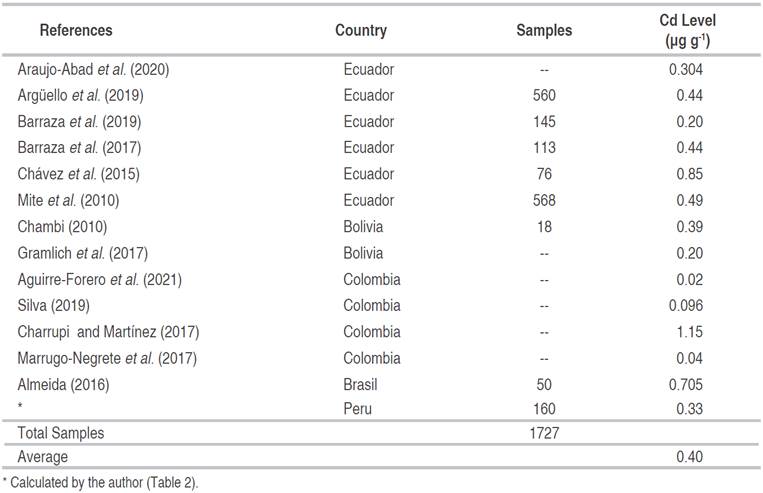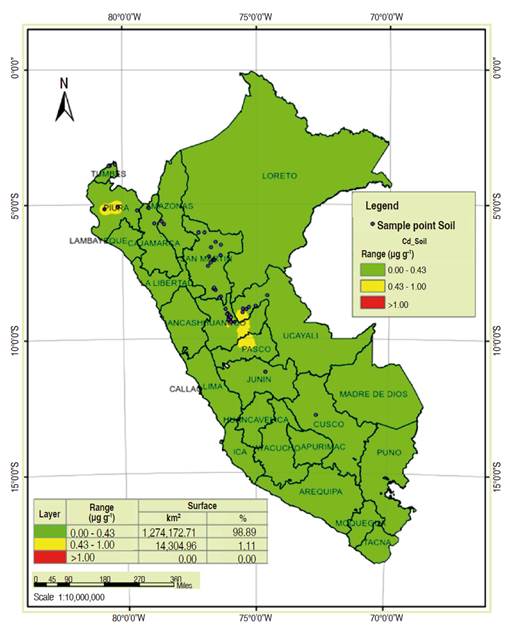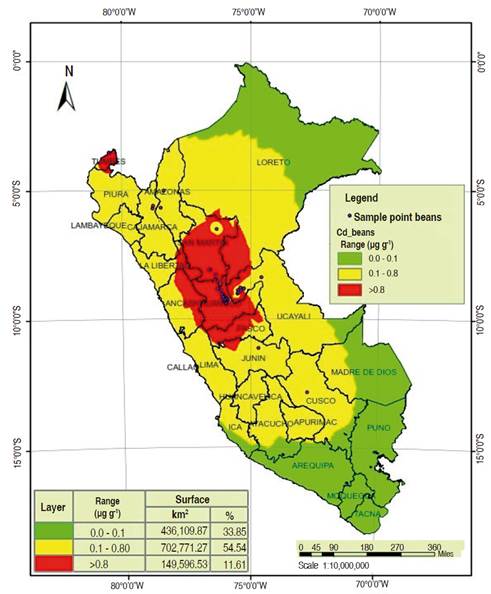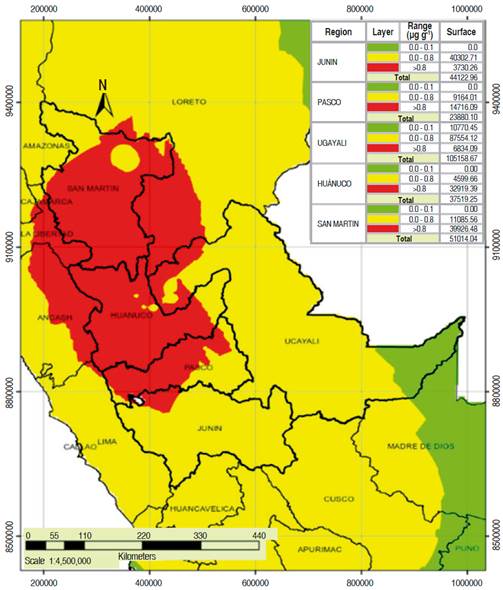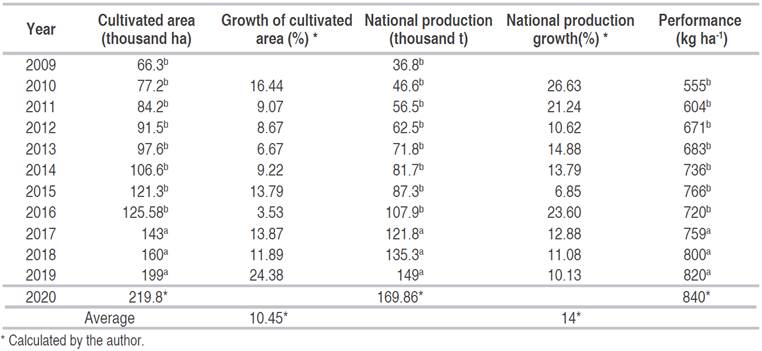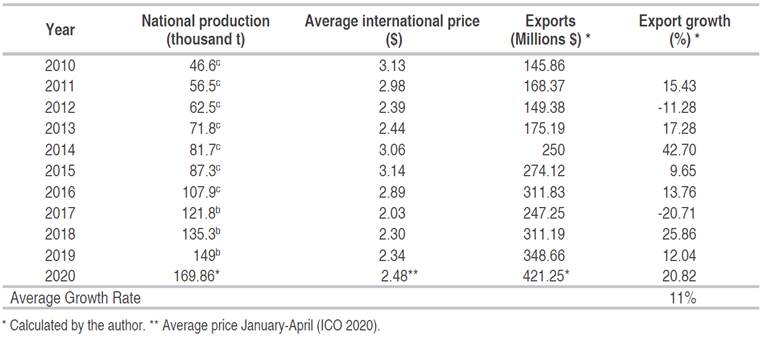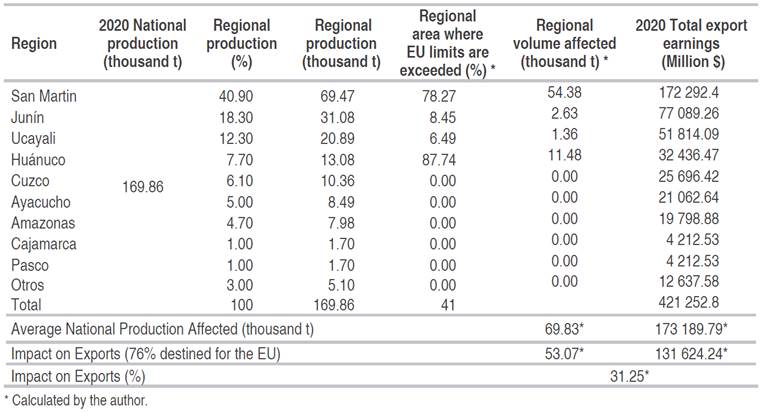INTRODUCTION
Cadmium is a heavy metal with no known biological function, the physicochemical properties of which are between Zn and Hg (Antoine et al., 2017). It was discovered in Germany in 1817 by Friedrich Stromeyer as an impurity in zinc carbonate (ZnCO3) (Pérez and Azcona 2012); its various applications in the industry started 50 years ago (Pérez and Azcona, 2012; Gunnar, 2013). However, it is currently causing a number of complications in vital organs such as lungs, kidneys, liver and bones either by inalation or ingestion, becoming in a potential threat to human health (Reyes et al., 2016; Ali et al., 2020). Despite being in low concentrations when compared to other metals, the impact on health, due to its high mobility and bioaccumulative power is alarming (Reyes et al., 2016; Engbersen et al., 2019). Even at trace levels cadmium can cause serious health complications (Maddela et al. 2020).
There was an incident in Japan in the 1950s where the people living on the banks of the Jintsu River were affected by the consumption of rice from crops that were contaminated with cadmium from mining (Reyes et al., 2016; Hernández-Baranda et al., 2019). From there, a series of studies was initiated which lead to cadmium, as well as lead, mercury, and chromium, to be considered as the elements most dangerous to human health (Casteblanco, 2018; Engbersen et al., 2019); particularly, because of their cumulative nature which can cause a series of damages to one's health (Prieto et al., 2009; Reyes et al., 2016; Maddela et al., 2020).
Soil generally has a low cadmium content (Kabata-Pendias, 2010), but regardless of the level and origin, the dynamics of the metal depend on its chemical form and the characteristics of the soil (Bravo et al., 2014; Díaz et al., 2018; Scaccabarozzi et al., 2020). This limits or contributes to the mobilization and uptake of cadmium from cacao plants (Gramlich et al. 2017; Zug et al. 2019); in some plant structures it is accumulative (Hernández-Baranda et al., 2017; Tantalean and Huauya, 2017; Casteblanco, 2018), and reaches concentrations that are higher than in the soil itself (Chávez et al., 2015; Díaz et al., 2018; Oliva et al., 2020). Due to this, the EU and some other countries have implemented standards to classify agricultural soil. Also, the EU has established tolerable limits for cacao beans and its by-products that are imported.
Taking into account the studies that warn of high levels of cadmium in cacao beans and processed cacao products of South American origin (Chávez et al., 2015; Lanza et al., 2016; Arévalo-Gardini et al., 2017; Gramlich et al., 2017; Díaz et al., 2018; Argüello et al., 2019), the recent EU provision, Regulation No. 488/2014, which entered into effect in 2019, sets tolerable values to be between 0.1 and 0.80 µg g-1 for products derived from cacao (EU, 2014; Jiménez, 2015). This will put the quality and export possibilities of cacao from Latin America at risk, and in particular those coming from Peru, whose main market is the EU, which makes up 76% of their exports (MINAGRI, 2019).
Therefore, the objective of this document was to evaluate, through the interpolation of data, the presence of cadmium available in the soil, its bioaccumulation in cocoa beans, and the technological advances for controlling it; as well as to analyze the potential effects on Latin America exports volumes, using Peru as a case analysis.
Cadmium in the soil
The U.S. Environmental Protection Agency (USEPA) established 0.43 µg g-1 to be a critical level of total cadmium in agricultural soil (USEPA, 2002). On the other hand, the EU through the Kelley Directive, indicated that the typical values in uncontaminated soil with cadmium are between 0 and 1 µg g-1 (Acevedo et al., 2005) and the recent supreme decree issued by the Peruvian Ministry of Environment, DS N° 011-2017 (MINAM, 2017) approved environmental quality standards (EQS) for soil, setting 1.4 µg g-1 as the maximum limit for the cadmium values of agricultural soil.
The natural average level of cadmium in agricultural soil fluctuates between 0.01 to 7 µg g-1 (Bohn et al., 1993); although more specific studies have found it to be between 0.07 and 1.1 µg g-1, with a natural base level of 0.5 µg g-1 (Kabata-Pendias, 2010). In addition, rock composition can elevate the cadmium levels in soil (Argüello et al., 2019); generally following the natural order of their evolution, with the lowest values being found in the most evolved soils, which have an acidic pH, low cation exchange capacity values and thick textures (Pérez and Azcona, 2012). Also, alluvial soil has been shown to have higher levels of available cadmium when compared with residual cadmium (Tantalean and Huauya, 2017; Scaccabarozzi et al., 2020); and the contribution of natural processes to the cadmium contamination of the soil is three to ten times less than in anthropogenic sources (He et al., 2015).
Naturally, soils have varing levels of cadmium, and the availability is subject to their physicochemical and biological properties; studies reveal relationships between cadmium and pH (Arévalo-Gardini et al., 2016; Florida et al., 2018). The higher the pH level of the soil, the greater the cadmium retention and the lower the cadmium contamination in cacao beans, according to the Kelley Directive (Acevedo et al., 2005). In addition, the cadmium concentration and mobility are influenced by the percentage of clay, the presence and type of organic matter (Bravo et al., 2014), the available cadmium (Sánchez et al., 2011; Gramlich et al., 2018), the cation exchange capacity, and the amount of mangnesium and zinc (Degryse et al., 2009; He et al., 2015; Arévalo-Hernández et al., 2017; Argüello et al., 2019; Zug et al., 2019). These authors suggest that the aforementioned indicators have a direct effect on the plant's absorption.
Geo-distribution of available cadmium soil
There are reports of high levels of cadmium in the soil of Latin America. Table 1 shows the average of the sampling work that is carried out at regional levels and even at national levels in some countries. The results reveal that on average, South America has 0.42 µg g-1, being categorized as having soil that is not contaminated by cadmium, according to the USEPA (0.43 µg g-1), which has the most stringent regulations established so far for agricultural soil.
Peru is considered megadiverse country due to its bioclimates and the fact that is possesses coastal, mountain and tropical soil (Pulgar, 2014). In addition, it is the center of the origin of the greatest diversity of cacao in the world (Motamayor et al., 2008); thus, it is a good representation of a caco producing country in South America for the case analysis. Table 2 shows Peruvian scientific reports from the different districts, provinces and regions of the country.
Table 2 Available cadmium in the soil of different cacao producing areas within Peru.
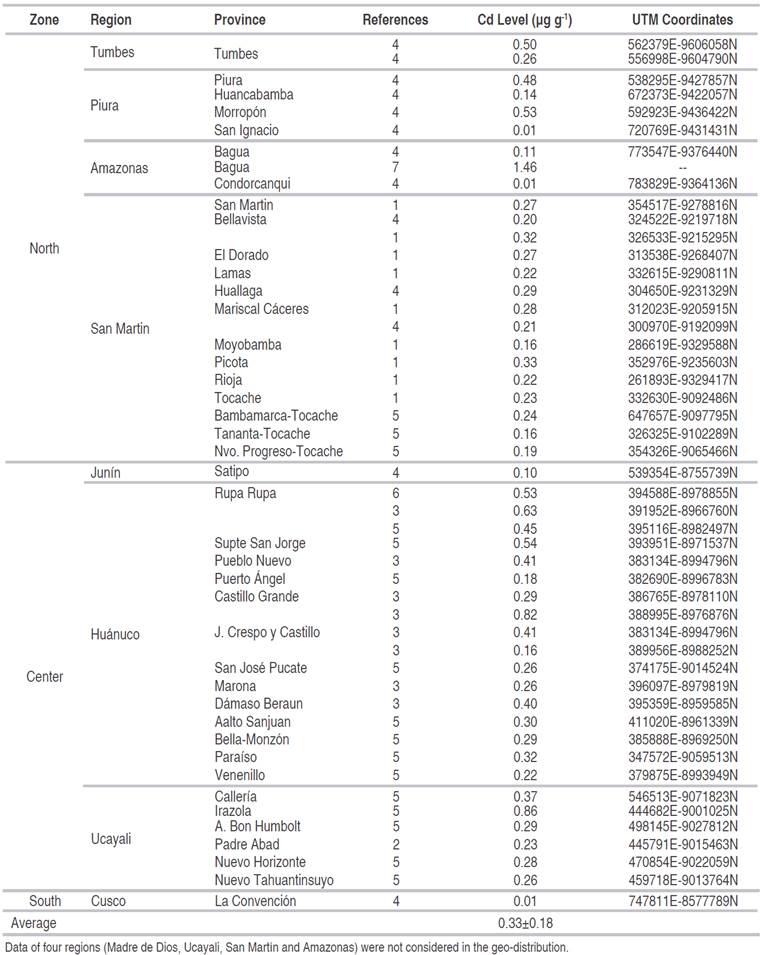
Source: 1 GRSM (2019); 2 Florida et al. (2019); 3 Florida et al. (2018); 4 Arévalo-Hernández et al. (2017); 5 COPAIN (2014); 6 Huamani et al. (2012); 7 Oliva et al. (2020).
Using these data of averages, a spatial analysis was performed through interpolation with the inverse distance weighting (IDW) extension in ArcGIS, version ArcMap10.5, to determine the geo-distribution of the available cadmium in the terirritory of Peru (Figure 2).
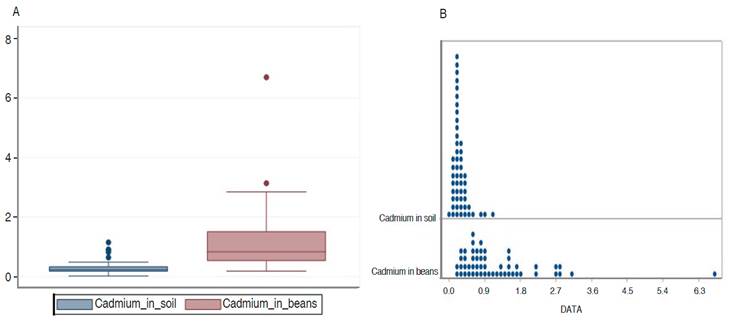
Figure 2 The dispersion of the available cadmium levels in the soil and the total cadmium in the cacao beans of the Peruvian territory. Diagram (A) and interquartile range (B).
Figure 1, through interpolation, shows the geo-distribution of the levels of available cadmium in soil and that it is determined that 100% of the territory is below the tolerable limit for agricultural soil, as set by Peruvian regulations and only 1.11% approach, but do not exceed EU limits (Kelley Directive); therefore, according to the interpolation, Peru has soil which is intended for cacao production and is not contaminated by cadmium.
Cadmium in cacao beans
The EU with Regulation No. 488/2014, established tolerable limits on cacao and chocolate derivatives: for milk chocolate with cacao solids less than 30%, 0.1 µg g-1; for chocolate with cacao solids of less than 50% and milk chocolates with cacao solids greater than or equal to 30%, 0.3 µg g-1; for chocolates with cacao solids greater than or equal to 50%, 0.8 µg g-1; and for cocoa powder, 0.6 µg g-1 (EU, 2014).
According to some countries, such as the United States, Food and Drug Administration (FDA) gives specifications for cadmium levels in bottled water, up to 0.005 mg L-1 according to the Code of Federal Regulations, 2013, Sec. 165.110. Title 21 of the Federal Code for Food and Medicines, chapter 163, details the different specifications for cacao products; there are no established levels for pollutants in this document, specifically for cadmium. In the case of Peru, there is no specific standard for cadmium levels in cacao, which is similar to other countries in the region, such as Chile (Food Health Regulations, title IV referring to pollutants), Bolivia (National Directorate of Standardization), Ecuador (NTE INEN 621: 2010) and Venezuela (La COVENIN 50: 1995 standard). It is important to note that the United States, Russia, Canada and Japan do not have limits for tolerable amounts of cadmium in cacao derivatives (Jiménez, 2015); thus, these could be alternative destinations for exports that exceed EU limits.
In this context, the soil has a low cadmium content, referring to both Peru (Figure 1), and the reports available for South American (Table 1), but research warns that cacao beans can capture cadmium and reach concentrations that are higher than the soil itself (Chávez et al., 2015; Díaz et al., 2018; Engbersen et al., 2019; Oliva et al., 2020). Moreover, most agree that bioaccumulation is higher in roots, leaves, pods and beans, with or without shell (Ramtahal et al., 2019; Barraza et al., 2017; Gramlich et al., 2017; Oliva et al., 2020), which is an aspect that can be analyzed.
Geo-distribution of cadmium in beans
Table 3 shows the average of the work that was done at regional levels in South American countries. The results reveal that, on average, the cadmium levels of cacao exceed those established by EU Regulation No. 488/2014 (maximum 0.8 µg g-1 cadmium). The results also show that beans have 2.1 times more cadmium in relation to the cadmium available in soil. This shows the bioaccumulation capacity of cacao and the potential impact on the possibilities of marketing this product to the EU, the main export market for cacao produced in Latin America.
Table 3 Total cadmium in cacao beans from some cacao-producing countries of South America.
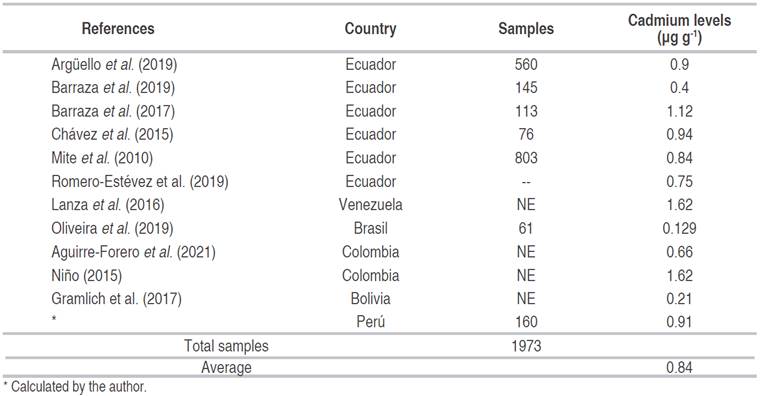
Table 4 shows the results of research throughout Peru and among different cacao genotypes; data was statistically analyzed with the Stata program (R) 15.1, to create box diagrams (Figures 2A), using the Minitab * 18.1 program, in order to determine interquartile ranges (Figure 2B).
Table 4 Total cadmium in cacao beans from different areas of production in Peru.
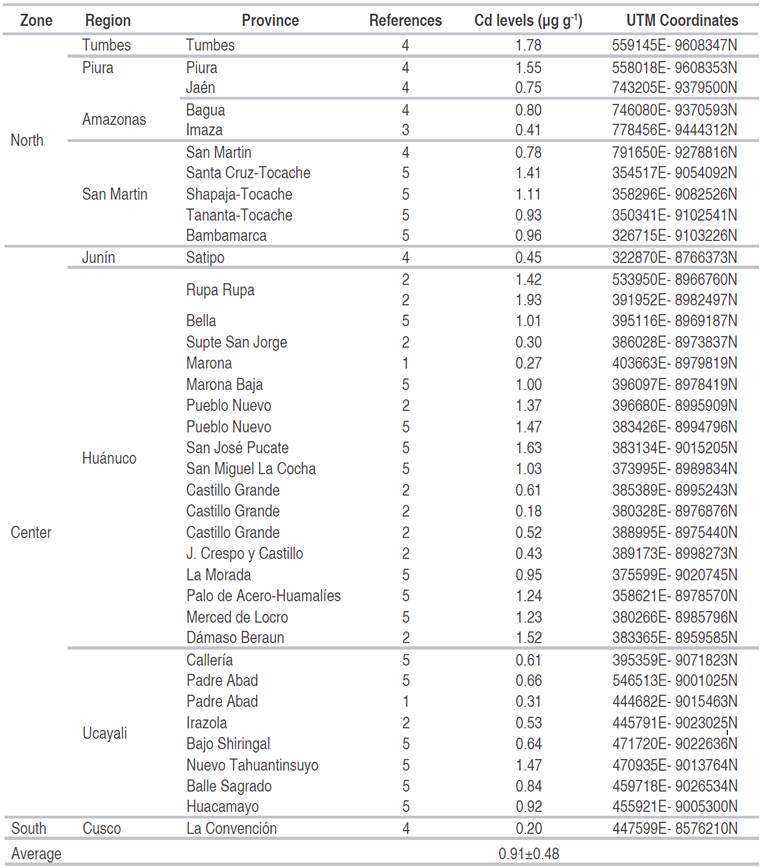
Source: Prepared by the author using data from 1 Florida et al. (2019); 2 Florida et al. (2018); 3 Llatance et al. (2018); 4 Arévalo-Hernández et al. (2017); 5 COPAIN (2014).
Figure 2A, shows that the average concentration of cadmium in Peruvian soil used for cacao production is 0.29±0.18 µg g-1 and in the beans it is 0.91±0.48 µg g-1, this latter is 3.13 times higher than the value calculated for South America (2.1 times more cadmium in relation to the available cadmium in the soil). Also, when looking at the interquartile range (Figure 2B), 50% of the cadmium in the soil is between 0.02 and 0.23, while in the beans it is between 0.18 and 1.52 µg g-1.
Figures 3 and 4 shows the geospatial analysis using data interpolation with the IDW extension of ArcGIS, version ArcMap10.5, software created in the USA.
The high bioacummulation capacity of cadmium in the cacao beans (Figure 2A and 2B) is relevant and suggests that current standards should take into account the natural level of cadmium in the soil as well as cacao genotipes, in order to establish average levels of cadmium, allowing the categorization of agricultural soil not contaminated with cadmium. In addition, it should not be confused with tolerable limits for derived or processed products in the commercialization of cacao beans (Pastor, 2017). Under current regulatory criteria, cadmium concentrations should be reformulated to classify soil, according to the cacao absorption capacity and the criteria proposed by Meter et al. (2019), who calculated a tolerable maximum limit for cadmium value in dry beans or raw cacao mass at 1.1 µg g-1.
Therefore, in the case of Peru, an uncontaminated soil should have a maximum of 0.36 µg g-1; far below the limits set by the current USEPA standards (<0.43 µg g-1), EU (<1 µg g-1) and by the Peruvian Ministry of Environment (<1.4 µg g-1) (Acevedo et al., 2005; Jiménez, 2015; Pastor, 2017). This would jeopardize the availability of areas for cacao production; however, it would prevent cacao production in heavily contaminated soils (Zug et al., 2019).
Data interpolation shows that the San Martin, Huánuco, Ucayali and Junín (central zone) and Tumbes (northern zone) regions have areas that exceed the tolerable limits as set by the EU; these areas represent 11.61% of the national territory (Figure 3). According to MINAGRI (2019) (acronym in Spanish) the Tumbes, Ancash and Pasco regions, together with other regions, contribute to only 3% of domestic production; therefore, they are not part of the calculations to measure the effects on future exports.
In addition, Figure 4 confirms the warnings of some researchers (Huamani et al., 2012; Arévalo-Hernández et al., 2017; Florida et al., 2018; Zug et al., 2019), since in central Peru, in 78.27% of San Martin, 87.74% of Huánuco, 6.49% of Ucayali, and 8.45% of the Junín region, there are areas with plantations that exceed the tolerable limits of cadmium, according to the EU, and these regions contribute to 79.2% of the domestic production (MINAAGRI, 2019); basic information for determining the effects on future exports.
Figure 4 shows geo-distribution by interpolating the total cadmium levels of beans from central Peru: in the San Martin region 78.27% of the total production areas have levels that exceed the limits that are tolerated by the EU, in Huánuco 87.74%, Junín 8.45% and Ucayali 6.49%.
Technologies for reducing cadmium levels in cacao beans
The geo-distribution (Figures 3 and 4) confirms that part of the Peruvian territory (central and northern zone) has beans with cadmium levels, which exceed the limits established by the EU, and similar to Peru, high levels have also been reported in parts of Ecuador (Mite et al., 2010; Chávez et al., 2015; Diaz et al., 2018; Argüello et al., 2019; Barraza et al., 2019), Venezuela (Sánchez et al., 2011; Lanza et al., 2016) , Colombia (Bravo et al., 2014; Jiménez, 2015; Rodríguez et al., 2019), Brazil (Oliveira et al., 2019) and Bolivia (Gramlich et al., 2017) . These countries contributed to world production with 12% in 2012 and 17% in 2019 (Morales et al., 2012; MINAGRI, 2016; Arvelo et al., 2017; Antolinez et al., 2020).
Cadmium in cacao is a challenge to overcome in the short term (Antolinez et al., 2020), therefore, appropriate technologies are needed to reduce cadmium levels in the beans and protect the product quality, as well as consumer health (Casteblanco, 2018; Engbersen et al., 2019; Maddela et al., 2020). In addition, the availability of the cadmium in the soil and its bioaccumulation in beans is influenced by natural concentration (Argüello et al., 2019), physical, and chemical factors of the soil, which can maintain control of metal mobilization and bioaccumulation (Prieto et al., 2009; Sanchez et al., 2011; Bravo et al., 2014; Arévalo-Gardini et al., 2017; Pereira et al., 2017; Florida et al., 2019) as well as the genotype of cacao grown (Arévalo-Hernández et al., 2017; Chupillon-Cubas et al., 2017; Barraza et al., 2019; Engbersen et al., 2019).
In this context, this research suggests that the most promising strategies to reduce cadmium in cacao beans its absorption by trees, adding soil amendments to alter soil characteristics, thus reducing the bioavailability of cadmium (Argüello et al., 2019; Meter et al., 2019). These agronomic techniques offer advantages because of their low cost and minimal environmental impact as compared to other remediation procedures (Mohamed et al., 2017). Moreover, these techniques have shown favorable results along with the application of organic, inorganic, and combined fertilizers. In this regard, at the laboratory level was demonstrated, that the retention and mobility factor of cadmium depend on the quality of organic matter. In Colombia, Bravo et al. (2014) found significant effect in these processes, in addition, a better quality causes a lower cadmium mobility, avoiding contamination and toxicity through bioaccumulation. Furthermore, Ramtahal et al. (2019) applied biochar and lime in vitro and found that the two amendments were complementary in their action and they can be used to reduce cadmium bioaccumulation. There are already successful experiences, including Florida et al. (2019) in Padre Abad, Peru, who applied compost and NPK and found a significant reduction in cadmium levels of soil for cacao production, as well as the beans. Also, in Venezuela, Sánchez et al. (2011) applied phosphorus doses and the amount of available cadmium decreased because of the phosphorus effect.
The use of amendments from organic and mineral origin, together with efficient microorganisms, showed better results. In Colombia, Cáceres and Torres (2017) found changes in the diversity of the microbial community of the soil associated with cacao cultivation, as well as, potential cadmium tolerant strains that can be used in on-site bioremediation programs or microorganisms can be used in order to produce biotechnological products. Revoredo and Hurtado (2017) evaluated the bioremedial activity of 3 strains of Streptomyces: Streptomyces variabilis (AB5 and X) and Streptomyces sp. (C2) in cacao plants using concentrations of 100 and 200 µg g-1 of Cd. The C2 strain showed bioremedial activity and reduced absorption by 39.67%. Also, Guerra-Sierra et al. (2014) found that the Aspergillus and Trichoderma genres have high percentages of cadmium biosorption in a liquid culture medium of 98.6% and 96%, respectively. These potential capabilities were studied by Mohamed et al. (2017) who used organic amendments, compost, and microorganisms (bacteria, fungi, mycorrhizae) and demonstrated that the integration of compost and microorganisms has a positive effect on reducing the bioavailability of cadmium in the soil.
Agroforestry systems have also demonstrated positive influences on the decrease of cadmium in cacao beans. In this context, Gramlich et al. (2017) found lower cadmium contents in agroforestry systems than in monocultures, further noting that specific absorption capacities of crops are related to the genotype and age of the plants. In Huánuco, Peru, Zug et al. (2019) assessed the influence of land management and the diversity of nearby vegetation; the increased biodiversity of plant species was positively correlated with the cadmium content in cacao, which may make them promising measures to counteract cadmium contamination in regions with high cadmium content in the soil.
The selection of cacao genotypes that have low bioaccumulation capacities for use in cadmium contaminated soils is another alternative (Engbersen et al., 2019). In Ecuador, Barraza et al. (2019) found differences in isotopes 114 and 110 of cadmium for three different cacao genotypes. In the same country, Barraza et al. (2017) found average values of 1.21±0.87 and 0.89±0.64 µg g-1 for the CCN51 genotype and other Ecuadorian national varieties. In the San Martin, Peru, region, Chupillon-Cubas et al. (2017) found that the absorption of cadmium for six cacao genotypes could be used as a pattern, and thus, found differences in absorption levels for both the aerial and root parts of the plants, with mean values for the EET-400 genotype being 13.18 and 6.55, common cacao (12.98 and 2.81), CCN-51 (11.89 and 3.31), POUND-12 (10.30 and 3.38), SCA-6 (9.57 and 5.92), and IMC-67 (6.78 and 2.12 µg g-1).
Also, Lanza et al. (2016) found different mean values for the genotypes: HNF (2.09), PNF (1.9), PF (1.82), PFC (1.76), HF (1.74), PFM (1.57), HFC (1.1), and HFM with 0.95 µg g-1. The use of genotypes with low heavy metal accumulation capacities could be an alternative in order to avoid bioaccumulation problems. Therefore, it is necessary to study the genotype indicative of each cacao producing region.
Phytoremediation with plant species that have the ability to accumulate and tolerate high concentrations of cadmium in harvestable tissue (Tariq and Ashraf, 2016) is another alternative to remove metal contaminants such as cadmium; through phytofiltration, phytostabilization, phytoextraction, phytolatization, and phytotransformation (Casteblanco, 2018). In this regard, some plant species with hyperaccumulative capacities have been identified, including sunflowers (Helianthus annuus), which are a hyperaccumulator for cadmium (Tariq and Ashraf, 2016); soybeans when up to 300 mg kg-1 of TiO2 nanoparticles are added to the soil, obtained up to 400% µg of cadmium per plant (Singh and Byeong, 2016). However, the process can be optimized if plant species are combined with microorganisms. According to Ahemad (2015), endophytic bacteria associated with hyperaccumulating plant species promote the efficiency of the process through three mechanisms: increasing the root surface area and root hair production; increasing the availability of metals; and increasing the transfer of soluble metals from the rhizosphere to the plant. Guarino and Sciarrillo (2017) used Acacia saligna, E. camaldulensis, rhizobacteria and mycorrhizals, and they found that phytostabilization can occur in the soil with lead, cadmium and zinc. Also, Hashem et al. (2016) found that the arbuscular mycorrhizals Glomus mosseae, Glomus intraradices, Glomus etunicatum and Bassia indica can be used to decrease the dispersion of cadmium in the soil.
Effect on exports
Global cacao production increased from 2005-2018 by approximately 800 thousand t; it reached almost 4.6 million (Cunha, 2018). Meanwhile, Ecuador produced, in the same period, 118 to 260 thousand t and went from making up 3% to 6% of the world´s production, becoming fourth among cacao-producing countries, showing an annual growth of 9.8% (Cunha, 2018). Peru also showed sustained growth in cacao, with it being the sixth largest crop, in terms of area, that is harvested in 16 regions, 57 provinces and 259 districts (INEI, 2017). According to Table 5, in the last 10 years the cultivated area has had an annual growth of 10.45%, so that by 2020 it is forecasted to reach an area of 219.8 thousand ha. Also, domestic production has had an annual growth rate of 14% and by 2020 it is forecasted to reach 169.86 thousand t, with a projected yield of 840 kg ha-1; the latter is due to the sustained increase (5%) of the performance, which increased from 555 in 2010 to 820 kg ha-1 in 2019. This is a very positive aspect for Peruvian production, which contributes to approximately 2% of the world´s production and ranks nineth in the world (MINAGRI, 2019).
Table 6 shows that in the last 10 years the price has remained relatively steady (ICO, 2020) and Peruvian exports have grown on average by 11%, from 145.86 million in 2010 to 348.66 million in 2019 and a record 421 million can be reached by the end of 2020, as long as prices in the first months of 2020 remain stable (ICO, 2020), despite the validity of the pandemic.
The high levels of cadmium identified by Peruvian research from areas were cacao has been produced for the past 10 to 15 years; plants of this age have higher cadmium concentration (Arévalo-Gardini et al., 2017; Florida et al., 2019; Zug et al., 2019). In addition, from 66.3 thousand ha in 2009 to 199 thousand ha in 2019, more than 66% of the nation's area, were young plantations with low cadmium levels, which are allowed by the EU. At the same time, the technique of mixing the product and the strict control of organic producers is practiced by those marketing the product; this, along with other aspects, reduces the levels of cadmium in the cacao beans. Therefore, the problem of high levels of cadmium in Peruvian cacao will begin to increase in the coming years, given that according to the INEI (2017), in the last decade, cacao was the second alternative crop to replace coca in Peru and it is reasonable that in the next decade, the growth rate of new areas will decrease and there will be an increase in plantations that exceed 10 years of age, and thus have high levels of cadmium.
Table 7 shows that these regions contributed to 79.2% of the domestic production. Therefore, the areas contaminated with cadmium in these regions represent 41% of the national production and affect 31.25% of the total volume of Peruvian exports to the EU; this represents 53.07 thousand t of cacao beans and 131,624 million dollars, which will have an affect on the following years if appropriate actions are not taken by the indicated sector.
FINAL CONSIDERATIONS
This research presented an analysis of research conducted in the major cacao-producing countries of South American. The available scientific data allowed determining that an average of 0.40 µg g-1 of available cadmium is found in the soil, classified as free of contamination by cadmium, according to the United States Environmental Protection Agency, which established a critical level at 0.43 µg g-1 of total cadmium in agricultural soil, and the EU, through the Kelley Directive, established a range of 0 to 1 µg g-1. However, an average of 0.84 µg g-1 of total cadmium was found in the beans, which exceeds the EU standards and exceeds the levels found in the soil by 2.1 times; revealing a high bioaccumulation of metal in cacao beans from this region, thus, jeopardizing its quality and marketability to South America's the main export destination, the European Union.
In the case of Peru, 100% of the territory has soil that is not contaminated by cadmium (0.29 µg g-1); however, it has high levels of cadmium in the beans (0.91 µg g-1), concentrated in the central region, which affects approximately 31.25% of exports, representing a decrease of 131,624 million dollar per year. In Latin America, Ecuador, has the soil with the highest cadmium levels, and Ecuador and Venezuela the highest averages of cadmium in the cacao beans.
Significant advances are being made in technology in order to reduce bioavailability and bioaccumulation in the beans through the application of amendments (organic, inorganic and combined), agroforestry systems, bioremediation, and genotype selection. In addition, proposals have been made to reformulate the criteria to establish the maximum cadmium levels in raw beans at 1.1 µg g-1, and a final proposal by the researchers is to redirect exports to markets that do not have limits for this metal, as a short term alternative.














